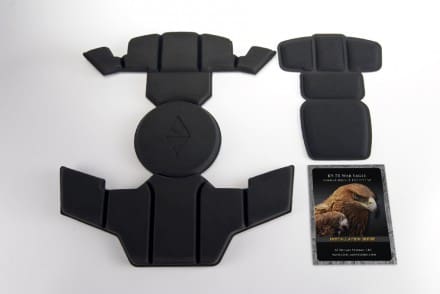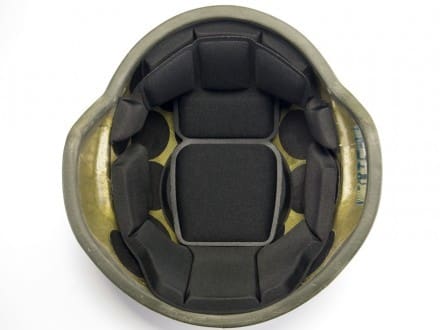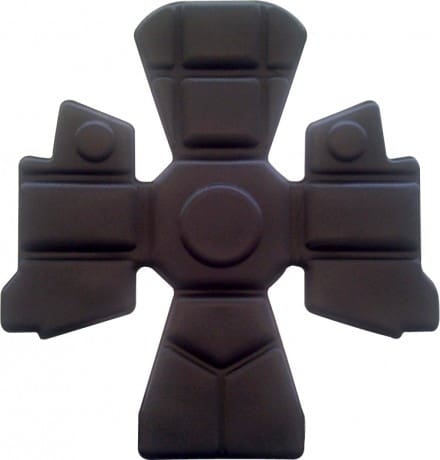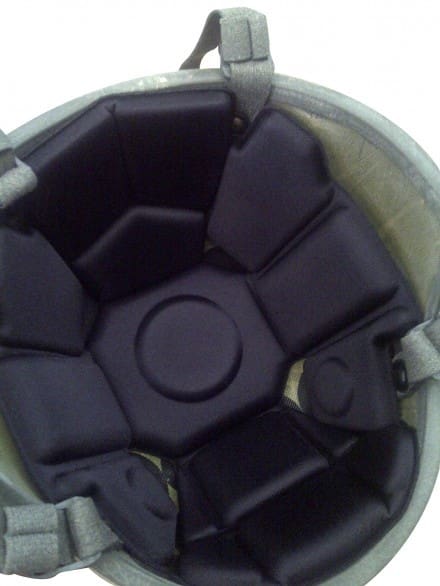(CHICAGO, Illinois, December, 2013) — A7 Helmet Systems, LLC, (“A7HS”), announced today that an independent laboratory has validated the extraordinary blunt-impact performance of the company’s ASH-22 BioRmr padding system for combat helmets. A7HS contracted an accredited third party, Chesapeake Testing Labs, to test the system in Advanced Combat Helmets (ACH) and tested it in accordance with AR/PD 10-02 Rev. A, Change 3, at all specified climate conditions (14oF, 70oF, and 130oF) at impact speeds of 10 ft/sec. and 14.1 ft/sec. The results showed that the average head acceleration for multiple impacts across all temperatures was 80.5G at an impact speed of 10 ft/sec., and 135G at an impact speed of 14.1 ft/sec. For context, the blunt-impact standard for padding systems currently used in the ACH is a maximum peak acceleration of 150G at 10 ft/sec., and the impact speed of 14.1 ft./sec. represents roughly a doubling of the impact energy. Accordingly, the ASH-22 BioRmr system meets the urgent needs of defense and law-enforcement agencies around the world for a practical and cost-effective way to improve the blunt-impact performance of ACHs and thereby help prevent or reduce the severity of blunt-impact induced brain injuries suffered by warfighters. The breakthrough was achieved as the result of an agreement between A7HS and U.K.-based D3O to share proprietary technologies related to impact-attenuation, including the exclusive use of D3O’s lightweight D3O Aero material in A7HS’s one-piece, adjustable ASH-22 design.
“A7 Helmet Systems has always thrived on the challenge of developing the best possible suspension and padding systems for combat helmets and we are proud to be the first and only company to have developed a system that meets and exceeds the 10 and 14.1 ft/sec. design goals,” stated Kerry S. Harris, a former U.S. Marine who is a founder of the company and designs all of the company’s systems. “Warfighters need and deserve the highest level of protection against blunt impact related concussions and other types of brain injuries and the validation of the ASH-22 BioRmr means we are on track to field the system in the first quarter of 2014.”
The ASH-22 BioRmr is an off-the-shelf, direct replacement for the 7-pad systems currently used in ACHs. It can be installed by a warfighter in the field in a matter of minutes without the use of any tools. The one-piece, multiconfigurable design means it can comfortably fit a wide variety of head shapes and helmet sizes while also providing optimum stability and airflow. “In designing a helmet suspension and padding system, there are a number of competing priorities, including blunt-impact protection, comfort, low weight, ease of use, durability, cost, and a small logistical footprint,” Harris said. “Besides providing unprecedented blunt impact performance and comfort for the warfighter, the ASH-22 excels in all of the other areas as well.”
To maximize the blunt-impact performance of the ASH-22 BioRmr, A7HS turned to the experts at D3O Lab and selected the company’s new, lightweight D3O Aero material. D3O Aero is an innovative, shock-absorbing material that is based on non-Newtonian principles. In standard conditions the material’s molecules flow freely, but on impact, the molecules lock together to absorb and dissipate the impact energy. After reducing the force transmitted to the head, it instantly returns to its soft and flexible state. “Because we set out to design and build the most innovative padding system, it made sense for us to research and test the most advanced materials,” Harris added.
“The lightweight D3O Aero proved to be a perfect fit and we look forward to quickly bringing the ASH-22 to warfighters throughout the world.” The agreement between A7HS and D3O Lab covers areas including development, production, marketing, and worldwide sales.
One of the most remarkable aspects of the ASH-22 BioRmr is its consistent performance at high impact speeds and at extreme temperatures. For instance, it is generally accepted that a peak head acceleration below 150G would have a low probability of causing a concussive head injury whereas a peak acceleration of 400G is considered to be the limit for serious head and brain injury. In 2005, the USAARL tested the current 7-pad system at an impact speed of 14.1 ft/sec., after being conditioned at 130o F and recorded a mean peak head acceleration of 411G. By contrast, when tested by Chesapeake Labs under the same conditions and protocol, the ASH-22 BIORMR recorded a mean peak head acceleration of only 126.5G. In fact, the mean peak head acceleration recorded for the ASH-22 BioRmr was below 150G at all impact speeds and conditions and the highest recorded peak acceleration for any one of the eighty-four drops to which the system was subjected was 178G. “Considering how much money taxpayers spend to treat warfighters who suffer TBIs each year, let alone the devastating effects TBIs can have on warfighters and their families, those test numbers have real meaning and the ASH-22 BIORMR should be seen as a game changer,” Harris commented. “We look forward to working with D3O and government agencies throughout the world to provide this protective technology for the men and women who fight our wars and protect our streets.”














































































































